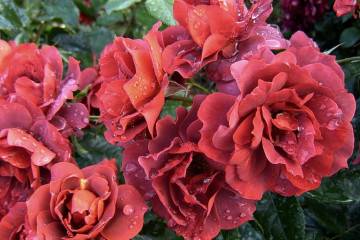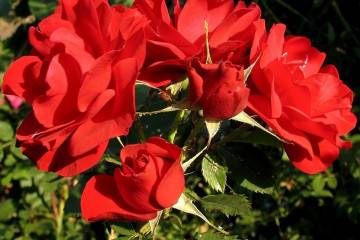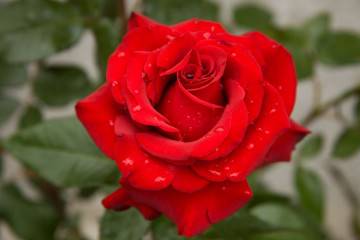Rose Ashram - description of a re-flowering culture
Content:
Rose Ashram is a beautiful variety that is becoming more and more popular with Russian flower growers. Its bright color and large flowers cannot go unnoticed. This rose with an oriental name will become the main decoration of the personal plot and front garden.
Rose Ashram - what is this variety, history of creation
Ashram hybrid tea rose has strong straight stems, large, slightly elongated leaves, painted in a rich green color. The flowers of the plant reach 10-18 cm in diameter. Lush buds are full of petals adjacent to each other. According to the description, their color varies from peach-orange to copper-brick shades. The maximum height of the bush is 70 cm. The stems grow up to a maximum of 120 cm in height. The plant has a delicate and light aroma.
The advantages of the variety include:
- decorativeness;
- unpretentious care;
- frost resistance;
- pleasant aroma;
- excellent resistance to fungal diseases
- the ability to stand in a vase for a long time after cutting;
- good tolerance to dry weather;
- long-term abundant flowering;
- re-flowering with proper care.
Ashram rose has its drawbacks, but there are far fewer of them. The flower is susceptible to the attack of aphids, spider mites and leaf rollers, it is afraid of rain and waterlogging.
The plant will perfectly fit into any landscape design. It will look great in combination with decorative cereals and conifers. You can also plant irises, phloxes, lilies, carnations and geraniums next to it. The flowering of the plant will favorably emphasize the emerald green lawn or contrasting colors of other varieties. Ashram roses are suitable for decorating flower beds and hedges.
Growing a flower, how to plant it in open ground
Before planting a flower, you need to choose the right place. For growing a rose, an area that is illuminated by the sun most of the day, with good air circulation, is suitable. You need to take care of the availability of protection from drafts, strong gusts of wind. The place should be located on a hill. Lowland cultivation will lead to a large accumulation of moisture, which is dangerous for the plant.
Planting a plant in open ground is carried out in April or in May, when the ground is warmed up to 12 ° C-15 ° C. The soil should be fertile and neutral in acidity. Very heavy or light soils are not suitable for the Ashram. If the soil is clayey, it is worth adding to it:
- peat;
- humus;
- sand.
Sandy soil requires the introduction of clay soil, mixed with manure and turf. The earth must be air permeable.
Rose seedlings are used for planting. Before planting, excess ground and underground shoots are removed from them, leaving only 1-3 of the strongest ones with developed buds. Long roots are shortened by 20-30 cm, and the damaged ones are cut off. Before planting, the seedlings are immersed in a solution of a root growth stimulator for a day.
Step-by-step planting procedure:
- Dig holes 60 cm deep.
- Lay 10 cm of drainage layer at the bottom of each.
- Fill the holes with fertile soil with organic fertilizers.
- Plant the seedlings so that the grafting site is 3-5 cm below the surface of the earth, and the roots are neatly straightened.
- Fill the holes with earth and tamp.
- Pour an earthen ring around the seedlings.
- Pour 1-2 buckets of warm water under each bush.
- Cover the earthen rings with mulch.
Plant care
The rose must be properly cared for. To do this, you need to follow simple care instructions. Basic procedures:
- watering at least 2 times a week in hot weather (15-20 liters of water per bush);
- application of nitrogenous fertilizers in spring, mineral and organic fertilizers before flowering;
- pruning shoots to 5-7 buds in the spring to ensure early and abundant flowering, and in the summer to remove faded buds and wilted shoots;
- frequent spraying at air temperatures above 25 ° C-28 ° C.
In the autumn, the frequency of watering is reduced to 3 times a month. In autumn, potash-phosphorus fertilizers are used and sanitary pruning is done, eliminating weakened and damaged shoots. For the winter, roses are covered with spruce branches and plastic wrap.
The plant is transplanted with the entire root system in early autumn or late spring. The shoots should have no flowers. After transplanting, the flower is abundantly watered and fertilized with organic compounds.
Blooming rose
This tea rose hybrid can bloom from late May to October. At first, the petals fit tightly to each other, and then slowly bend back. The opened flowers stay on the bush for a long time. They can be single or combined into inflorescences in the amount of 3-5 pieces on one stem.
The rose may not bloom due to:
- wrong landing site;
- poor pruning;
- violations of the rules of care;
- natural aging.
Flower propagation
The rose is propagated exclusively by the vegetative method. This helps the variety not to lose its uniqueness. After the end of the first phase of flowering, cuttings are cut from young bushes. They are then rooted by placing them in the ground and covering them with a transparent jar. The seedlings are ventilated daily and moderately moisturized.
Diseases, pests and ways to control them
The most dangerous diseases for a plant:
- Mealybug;
- Rust;
- Chlorosis.
As already mentioned, insects such as spider mites, leafworms and aphids can harm the flower. By spraying with special chemicals, the plant can be saved. The procedure is carried out several times with an interval of 5-7 days.
Growing and caring for a variety is not as difficult as it might seem. Instead, the rose will delight with abundant and spectacular flowering.



















